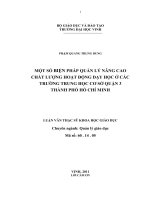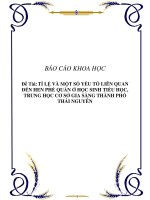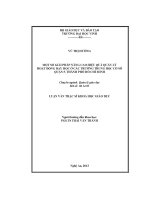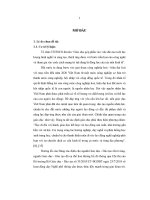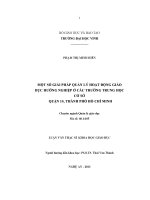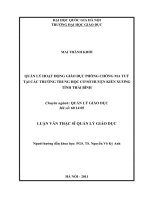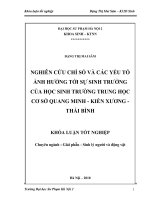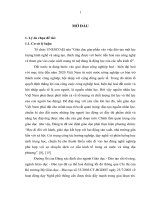Các yếu tố ảnh hưởng tới động lực học kĩ năng đọc tiếng anh của học sinh lớp 8 trường trung học cơ sở đông hòa thành phố thái bình
Bạn đang xem bản rút gọn của tài liệu. Xem và tải ngay bản đầy đủ của tài liệu tại đây (1.3 MB, 65 trang )
THAI NGUYEN UNIVERSITY
SCHOOL OF FOREIGN LANGUAGES
DANG THI THU HA
FACTORS AFFECTING GRADE EIGHT
STUDENTS’ MOTIVATION IN LEARNING READING
SKILLS AT DONG HOA SECONDARY SCHOOL
IN THAI BINH CITY
(Các yếu tố ảnh hưởng tới động lực học kĩ năng đọc tiếng Anh
của học sinh lớp 8 trường Trung học cơ sở Đông Hòa
Thành phố Thái Bình)
M.A THESIS
Field: English Linguistics
Code: 8220201
THAI NGUYEN – 2019
Số hóa bởi Trung tâm Học liệu và Công nghệ thông tin – ĐHTN
THAI NGUYEN UNIVERSITY
SCHOOL OF FOREIGN LANGUAGES
DANG THI THU HA
FACTORS AFFECTING GRADE EIGHT
STUDENTS’ MOTIVATION IN LEARNING READING
SKILLS AT DONG HOA SECONDARY SCHOOL
IN THAI BINH CITY
(Các yếu tố ảnh hưởng tới động lực học kĩ năng đọc tiếng Anh của
học sinh lớp 8 trường Trung học cơ sở Đông Hòa
Thành phố Thái Bình)
M.A THESIS
(APPLICATION ORIENTATION)
Field: English Linguistics
Code: 8220201
Supervisor: Dr. Hoang Thi Nhung
THAI NGUYEN – 2019
Số hóa bởi Trung tâm Học liệu và Công nghệ thông tin – ĐHTN
ACKNOWLEGEMENTS
I would like to express my deepest gratitude to all those who gave me the
possibility to complete this thesis.
First of all, I am deeply indebted to my beloved supervisor, Dr. Hoàng Thị
Nhung for the invaluable support, enthusiastic guidance, and encouragement she
gave me throughout my research. I am truly grateful to her for her advice and
suggestions right from the beginning when this study was only in its formative
stage. Without her untiring patience in reading the manuscript and clarifying my
ideas, the thesis would have never been in the current shape.
Secondly, I would like to give our thanks to all lectures of Postgraduate
Faculty at Thai Nguyen University for their valuable teaching and tremendous
assistance that have enlightened my study path.
Thirdly, I am also indebted to the field workers who were kind enough to
tolerate the painstaking task of collecting the data. Then my thanks also sent to my
classmates at the Master Course Class who have taken time and trouble to alert me to
errors in my thesis and provided me with useful data on which this thesis is based.
I also wish to send my sincere thanks to the teachers and students at Dong
Hoa secondary school in Thai Binh city, where I taught in order to gather
information for my survey questionnaires. Without their help, this study could not
have been successful.
Finally, I would like to express my gratitude to family members whose
support and encouragements have greatly contributed to the completion of my
study. For my little experience and knowledge, I would like to receive more useful
comments from lectures and others.
i thông tin – ĐHTN
Số hóa bởi Trung tâm Học liệu và Công nghệ
DECLARATION
I hereby declare that no part of the enclosed Master Thesis has been copied
or reproduced by me from any other’s work without acknowledgement and that the
thesis is originally written by me under strict guidance of my supervisor.
ii thông tin – ĐHTN
Số hóa bởi Trung tâm Học liệu và Công nghệ
ABSTRACT
The present thesis has been carried out on the background of the
achievement and deficiencies in the existing studies on Factors affecting grade eight
students’ motivation in learning reading skills. This thesis tries to understand the
phenomenon under investigation from a more extensive perspective through
analyzing the Factors affecting grade eight students’ motivation in reading skills
from text books, supplementary books and the acquisition of reading skills in
secondary schools. A detailed analysis of Factors affecting grade eight students’
motivation in learning reading skills is presented. Teachers and researchers have
broadly accepted motivation as one of the most important elements in foreign
language (L2) learning. The present research investigated the role of motivation and
factors affecting students’ motivation in teaching/learning English as foreign
language. Parental, environmental, and teacher’s attitude-related factors were
examined. Participants were 80 grade eight students studying at Dong Hoa
secondary school in Thai Binh. The participants were given a survey which
consisted of several statements related with the mentioned factors. The current
thesis showed that there were strategies and behaviors that motivate students but
suppress positive attitudes towards English learning. The findings showed that
students were more motivated when their parents supported and encouraged them to
learn English. The thesis also revealed that reinforcing the learner beliefs also
motivated students and they were more motivated when they worked with their
friends. Furthermore, the findings of this study suggested many behaviors and
strategies which motivate learners. The findings of this thesis have profound
theoretical and practical meanings on relative topics.
iii thông tin – ĐHTN
Số hóa bởi Trung tâm Học liệu và Công nghệ
TABLE OF CONTENT
ACKNOWLEGEMENTS ........................................................................................... i
DECLARATION ....................................................................................................... ii
ABSTRACT .............................................................................................................. iii
ABBREVIATIONS................................................................................................... vi
LISTS OF TABLES AND FIGURES ..................................................................... vii
PART I: INTRODUCTION .....................................................................................1
1.1. Rationale of the study...........................................................................................1
1.2. Aims of the study .................................................................................................2
1.3. Research questions ...............................................................................................3
1.4. Scope of the study ................................................................................................3
1.5. Significance of the study ......................................................................................3
1.6. Design of the thesis ..............................................................................................3
CHAPTER 1: LITERATURE REVIEW ................................................................5
1.1. Theoretical background of reading ......................................................................5
1.2. Motivation ............................................................................................................7
1.3. Motivation factors ..............................................................................................10
1.3.1. The teacher’s factors .......................................................................................11
1.3.2. Parental factors ................................................................................................13
1.3.3. Classroom characteristics or environmental factors .......................................15
1.4. Summary ............................................................................................................16
CHAPTER 2: RESEARCH METHODOLOGY .................................................17
2.1. Introduction .........................................................................................................17
2.2. Research questions .............................................................................................17
2.3. Research participants .........................................................................................17
2.4. Research procedure ............................................................................................18
2.5. Data collection instrument .................................................................................18
2.6. Data analytical method .......................................................................................21
CHAPTER 3: DATA ANALYSIS .........................................................................22
iv thông tin – ĐHTN
Số hóa bởi Trung tâm Học liệu và Công nghệ
3.1. Introduction ........................................................................................................22
3.2. An over view of results ......................................................................................22
3.3. Results of data analysis ......................................................................................26
3.4. Discussion ..........................................................................................................27
CHAPTER 4: MAJOR FINDINGS AND SUGGESTIONS ...............................30
4.1. Introduction ........................................................................................................30
4.2. Results ................................................................................................................30
4.3. Major findings ....................................................................................................37
4.4. Suggestions for improving students’ motivation in learning reading skills ......39
PART III: CONCLUSION .....................................................................................41
REFERENCES ........................................................................................................44
PHIẾU ĐIỀU TRA HỌC SINH .............................................................................47
PARENTAL FACTORS .........................................................................................52
QUESTIONAIRE ....................................................................................................56
v thông tin – ĐHTN
Số hóa bởi Trung tâm Học liệu và Công nghệ
ABBREVIATIONS
e.g: Exempli gratia (for example)
etc: et cetera
3Rs: Three Skills of Reading Namely Reading, Writing, and Counting
CBP Children Book Project
L1: First language
L2: Second language/ Foreign language
ELLs: English language learners
(S1): each sentence is assigned a number in the list of motivations provided by the
participants.
Italics type is used for terms and examples
vi thông tin – ĐHTN
Số hóa bởi Trung tâm Học liệu và Công nghệ
LISTS OF TABLES AND FIGURES
LISTS OF TABLES
Table 2.1. Information on the research participants..................................................18
Table 3.1. Parental Factors ........................................................................................23
Table 2.2. Teachers' factors .......................................................................................24
Table 3.3. Classrooms' factors ..................................................................................25
LISTS OF FIGURES
Figure 4.1.
Forms of questions ..............................................................................30
Figure 4.2.
The time students spend reading at home ...........................................31
Figure 4.3.
Like or dislike learning reading skill ..................................................31
Figure 4.4.
Is a complex and not well organized reading difficult to
understand? ..........................................................................................32
Figure 4.5.
Before reading a text, do you consider what you already know
about the subject? ................................................................................32
Figure 4.6.
Comments about reading lessons ........................................................33
Figure 4.7.
Reading texts the teacher gave students as homework .......................33
Figure 4.8.
Activities that teachers give before reading texts ...............................34
Figure 4.9.
High and low achieving students’ reading achievement and
reading motivation through teachers’ help ..........................................35
Figure 4.10. Students ask parents to help when reading at home ............................35
Figure 4.11. Effects of environments when students reading..................................36
Figure 4.12. Effects of classroom environments when students reading Statement/
Degree .............................................................................................................. 52
vii thông tin – ĐHTN
Số hóa bởi Trung tâm Học liệu và Công nghệ
PART I: INTRODUCTION
1.1. Rationale of the study
Today, the trend of international integration in many areas including the field
of education has put English in a very important position. English is the
communication tool, the key to the human treasure. Other widespread use of
information technology has made English learning urgent and indispensable. As a
result, the English language education of students of secondary education is of
particular interest to students, parents, teachers, and the country. English is one of
the core subjects in the curriculum. Generally, English teaching for students in
Vietnam aims at providing the students with the ability to understand written
materials. Thus, the acquisition of reading skills is a priority for most students. In
addition, English is taught and learnt in a non-native environment so reading is an
important means to gain knowledge not only of the language itself but also of other
fields like culture.
These days reading is one of the most important key skills for most students
learning a foreign language. Learning a foreign language is a process, which
requires learners to integrate the language skills: reading, writing, listening and
speaking, among which reading should take place alongside the development of oral
ability in the school program. Reading itself has proved its importance in daily life
as well as in teaching and learning a foreign language.
Reading is an activity which involves comprehensions and interpretations of
ideas symbolized by written or printed page. It is clear, without this ability students
will find themselves confronted with strange and weird symbols which will make
no sense for them. Very low level ability of reading allows a reader to differentiate
the letters of a particular language from non-linguistic marks
Being able to read in a foreign language is often important to academic
studies, professional success and personal development. However, in learning a
foreign language, the process of reading and understanding the true message
conveyed by the author in reading text is undoubtedly a complicated and significant
Số hóa bởi Trung tâm Học liệu và Công nghệ thông tin – ĐHTN
task. There are a lot of difficulties for the learners to achieve the goal of mastering
the content of the text and complete the enclosed task in the reading requirement.
Also, the teachers of the foreign language often have difficulties in successfully
helping his learners during the course of reading.
It is important that teachers need to find what motivates students to read.
Teachers must restore the love and interest for reading in today’s adolescent. Many
teachers hold the same goal for their students and that is for them to want to read
(Johns & Lenski, 2005). So, there is a task for teachers is to discover what
motivates individual learners and work to reach each and every learner. By
exploring the issue teachers are able to not only help unmotivated readers develop
motivation towards reading but also to foster and to continue the motivation that
already exists in engaged readers.
Being an English teacher, the researcher has always been aware of the
importance of developing reading skill for students. Within the scope of this study,
the researcher seeks to aim at a study on finding factors affecting grade eight
students’ motivation in learning English reading skills at Dong Hoa high school.
This paper will prove useful both for teachers and students at secondary level. This
research will also help researchers in future to move forward with a better vision to
improve reading comprehension. The role of reading skill in improving other
linguistic skills and the role of reading skills in our educational systems will also be
brought in consideration.
1.2. Aims of the study
Motivation plays a very important role in enhancing students' English
reading ability. Dornyei (1998) emphasizes the influence of motivation, which is
considered the key to learning second language (L2) and is one of the biggest
factors affecting the success of language learners. It is widely accepted that the
more motivated students become more successful when studying second/foreign
languages. Students who choose English are specialized and learn it as a foreign
language interested in motivational factors that play a major role in learning,
developing skills and practicing English in use daily. The study will explore the
Số hóa bởi Trung tâm Học liệu và Công nghệ thông tin – ĐHTN
attitude of parents, the environment and teachers-related motivational factors among
those who learn to read English, and help understand strategies that can enhance
learning to read. In the section of the factors related to the attitude of teachers, the role
of teachers and the implementation of specific motivation strategies in the class of
reading skills of eighth graders will be studied. In the section of parental elements, the
study will examine the parents' behaviors and beliefs in English education for their
children, which affect their reading motivation more. In addition, environmental
components that motivate English reading students will be investigated.
1.3. Research questions
(i). What factors influence eighth-graders' motivation to learn English
reading skills?
(ii). What is the relationship between high- and low-achieving students’
reading achievement and reading motivation?
1.4. Scope of the study
There are ten classes of grade eight and eleven English teachers at Dong Hoa
secondary school. Students study all four English skills in the official textbook.
However, the study is limited only to students’ English reading skill of the four classes
of grade eight and all English teachers of the school.
1.5. Significance of the study
The significance of this study can be discussed from two major perspectives:
(i). Theoretically, the systematically organized information in the thesis may
help learners gain an insight into English skills in the official textbook.
(ii). Practically, the thesis, to the extent possible may serve as a guide for Dong
Hoa grade eight students in the implementation of specific motivation strategies in
the class of reading skills.
1.6. Design of the thesis
The thesis consists of three parts:
PART I: INTRODUCTION
This part includes the basic information such as the rationale of the study,
aims, research questions, scope and methods of the study.
Số hóa bởi Trung tâm Học liệu và Công nghệ thông tin – ĐHTN
PART II: DEVELOPMENT
There are four chapters in this part. They are:
Chapter 1: Literature Review
The chapter provides theoretical backgrounds of reading skills and
motivation. In this chapter, the theories for the nature of reading, motivation,
motivation in reading and main factors affecting motivation in English reading
learning are discussed.
Chapter 2: Research methodology
The chapter presents the methodology used in this study including research
procedure, data collection instruments, data analytical method........
Chapter 3: Data analysis
The chapter covers an analysis on the data collected from the survey,
interview and observation.
Chapter 4: Major findings and suggestions
The chapter offers some major findings and suggestions for improving
students’ motivation in learning reading skills.
PART III: CONCLUSION
This part summarizes the conclusion and limitations of the study.
Số hóa bởi Trung tâm Học liệu và Công nghệ thông tin – ĐHTN
PART II: DEVELOPMENT
CHAPTER 1: LITERATURE REVIEW
This chapter is concerned with the theories of second language reading and
motivation. Three main features will be presented: theoretical background of
reading, theoretical background of motivation and motivation in English reading
learning, main factors affecting motivation in learning reading skills.
1.1. Theoretical background of reading
There are many theorists and researchers in the fields of linguistics, psychology
and language teaching attempting to define reading. Although the essence of reading
has long been investigated, no single research could be exhaustive and comprehensive
enough to include all the aspects of the actual reading activity. They gave definitions
with the purpose of trying to give a conceptual view about what reading is, how it takes
place, and mechanisms that underlie it. Most of the definitions that have been
elaborated to explain reading, however, agree on the fact that it includes underlying
intricate procedures and mechanics.
According to William (1994), “reading is a process whereby one looks at and
understands what has been written” and “written texts often contain more than we
need to understand them. The efficient reader makes use of this to take what he
needs, and no more, to obtain meaning”. This view is also shared by Nuttall and
Grellet. They assert that “reading is getting a message from a text” (Nuttall, 2000)
and “reading comprehension is understood as extracting the required information
from a written text as efficiently as possible” (Grellet, 1992).
SIL International (1999) defines: “ True reading requires both the ability to
break down the code and the ability to understand the meaning intended by the
writer”. This definition can be explained as follow:
In the communication process, the writer or the speaker ( the encoder) has a
message in his mind. If he wants to share and to make this possible, he must put his
massage into words or encode it. When the message is decoded by the hearer or the
reader, communication is achieved. Therefore, reading can be understood as “a
Số hóa bởi Trung tâm Học liệu và Công nghệ thông tin – ĐHTN
psycholinguistic process by which the reader, a language user, reconstructs, as best
as he can, a massage which has been encoded by a writer as a graphic display”
(Goodman, 1996).
Harmer (1983) asserts that “[r]eading is an exercise dominated by the eyes
and the brain [...] The eyes receive messages and the brain has to work out the
significance of these messages”.
Harmer’s (1983) definition concentrates on the reading skill as a receptive
one because it regards how written texts-and other forms of written materials-are
perceived as images by the eyes, and then, the transmission of these images as
signals through optic nerves to the brain, which is the centre responsible of giving
corresponding meanings to the messages. Moreover, some other approaches to
reading have established that word recognition is a prerequisite condition for
effective reading to take place. Adams (1990, p.1) asserts that decoding the words
of the text separately is important to build an overall understanding of the text.
In addition to that, Smith (1994) claims that reading is much more than
simply recognising written symbols, and then, matching them to corresponding
sounds; “reading is a matter of making sense of written language rather than
decoding print to sound” (Smith, 1994, p.2). Besides emphasising the concept of
meaning and its role in reading, Smith (1994) furthermore describes understanding
as a basis rather than an outcome of successful reading. He claims that readers will
not be able to comprehend any passage if they do not bring to the activity their own
understanding of the world, experience and prior knowledge.
According to Nunan (2003:68), reading is a fluent process of readers
combining information from a text and their own background knowledge to build
meaning. Mikulecky (2011:5) states that reading is a complex conscious and
unconscious mental process in which the reader uses a variety of strategies to
reconstruct the meaning that the author is assumed to have intended, based on data
from the text and from the reader’s prior knowledge.
Ahuja and Ahuja (2001:5) also state that reading is both a sensory and
mental process. It involves use of the eye and the mind. The eyes receive messages
Số hóa bởi Trung tâm Học liệu và Công nghệ thông tin – ĐHTN
and the brain has to work out the significance of this messages. It requires the
students to read for meaning. It means that they not only read the text but also
understand the meaning of written text being read.
Moreover, Patel and Jain (2008:113–114) stated that “Reading is an
important activity in life with which one can update his/her knowledge. Reading
skill is an important tool for academic success. Reading is the most important
activity in any language class. Reading is not only a source of information and a
pleasurable activity but also as a means of consolidating and extending one’s
knowledge of the language. Reading is very necessary to widen the mind, again and
understanding of the foreign culture”.
Though the previously stated definitions are apparently very different, they
carry the essence of reading. Reading is a process. This implies that in order to
achieve a successful comprehension, which is the ultimate goal of the reading
activity, the reader should go through a series of steps and levels that start as soon
as the reader looks at the written material.
Reading deals with written material. We do not read only what is known to
common people as letters and numbers put on a paper. In our daily life, we read
different kinds of materials that range form letters, newspapers, articles, books,...
All these are being processed in the same way and the aim is to draw meaning.
Therefore, reading is so important to open our knowledge.
1.2. Motivation
Motivation is one of the most important components deals to the successful
in teaching and learning. It plays a main role in mastering any target language
learning (Dornyei, 2005; Celce- Murcia, 2001).
According to Maslow (1970), motivation is the inner force which pushes a
person towards a goal based on individual needs. In relation to learning, motivation
to learn depends on student’s personality, learning styles and student’s view of what
is being learned (Keller & Burkman, 1993).
Gardner (1972) argues that motivation is directly affects L2 achievement and
there is a positive correlation between motivation and L2 achievement in a study.
Số hóa bởi Trung tâm Học liệu và Công nghệ thông tin – ĐHTN
This study adapts the Keller’s theory of motivation which comes out with ARCS
model. The principles embedded in this theory are as mentioned by Keller, 1979: In
brief, we can say that in order to have motivated students, their curiosity must be
aroused and sustained; the instruction must be perceived to be relevant to personal
values or instrumental to accomplishing desired goals; they must have the personal
conviction that they will be able to succeed; and the consequences of the learning
experience must be consistent with the personal incentives of the student (pp. 6-7).
Motivation is considered as the power that leads individuals to do something in
different domains. Nonetheless, people are often reluctant to engage in doing
something they are required to do for a lack in motivation; and, thus, the necessity
for motivating them emerges. From a behaviourist viewpoint, motivation is “quite
simply the anticipation of reward” (Brown, 2007, p.168). In order to reach
additional reinforcement, individuals behave according to their previous experience
with reward for a particular behaviour and their need to gain new encouraging
incentives. This view sees performance as subject to external factors such as family,
teachers, and educational necessities.
The principles mentioned earlier define the elements (ARCS) which are necessary
to support students’ intrinsic and extrinsic motivation (Keller & Suzuki, 2004).
Intrinsic motivation (IM) in language learning refers to motivation to involve
in an activity because the activity is enjoyable and interesting to take part.
Extrinsic motivation (EM) refers to a performance which an individual
performs in order to gain reward such as good grades or to increase salary, or
alternatively to avoid from punishment. The first element is “A” stands for
“Attention” refers to using various techniques to attract students’ attention in class
(Keller, 2008). Next is “R” stands for “Relevance” refers to passages given by the
teacher is relevance to students’ experience. The lesson must be compatible with the
students’ proficiency level and related to students’ past experience (Keller &
Suzuki, 2004). Then, “C” stands for “Confidence” is the element which makes the
students believe that they can succeed and understand in the learning task (Keller &
Suzuki, 2004) for example, they are able to answer questions verbally and in
Số hóa bởi Trung tâm Học liệu và Công nghệ thông tin – ĐHTN
writing. The first three elements create the motivation to learn (Keller & Suzuki,
2004) but the last element is “S” stands for “Satisfaction” refers to students’
satisfying experience during the learning process (Keller, 2008). If all the
conditions (ARCS) are combined together then students most possibly have a high
motivation to learn. The researcher carried out a study using Keller’s instrument to
measure students’ motivation towards learning English reading comprehension.
On other word, techniques of teaching are important to motivate students in
learning EFL. Related to motivation, there are many researchers agree that there is a
correlation between motivation and learning achievement as can be seen from
previous studies below.
Guthrie and Wigfield (2000, p.405) propose that “reading motivation is
the individual’s personal goals, values, and beliefs with regard to the topics,
processes, and outcomes of reading”. According to this definition, one would
come to two main conclusions: The first is that reading motivation is made up of
the putting together of different aspects of motivation in a complex way. The
second is the kind of agency individuals have over it since they can manage,
organize and direct their motivation to read according to their beliefs, values and
goals (Wigfield & Tonks, 2004).
In a research treating the dimensions of reading motivation, Baker and
Wigfield (1999) confirm the view about the multidimensionality of reading
motivation (Guthrie, Wigfield & VonSecker, 2000). Paris and Carpenter (2004)
argue that this feature in reading motivation has to do with the nature of
motivation as “a difficult psychological construct to define and measure, and
[consequently] there is no single way to view or assess children’s motivation for
reading” (p.78).
Engaged reading are also said to be motivated for reading. Guthrie,
Wigfield, and Perencevich (2004) claim that, for example, engaged readers are
intrinsically motivated, have a positive belief about their competence, and
assimilate values they hold about reading to their own value.
Số hóa bởi Trung tâm Học liệu và Công nghệ thông tin – ĐHTN
Moreover, Guthrie and Wigfield (2000) stipulate that motivation “is
crucial to engagement because motivation is what activates behavior” (p.406). In
other words, motivated readers engage in a reading activity by investing more
energy and time than they are likely to do with on other activities (Wigfield &
Tonks, 2004). Similarly, motivation determines how dedicated readers are.
Wigfield and Guthrie (2004, p.260-1) maintain that motivation “is one of the key
factor that helps students persist when these challenges arise”.
Despite their crucial role, both reading motivation and reading engagement
are affected by readers’ past experience with reading materials as well as with
classroom settings where they have learned to read in the sense that they prevent
both reading motivation and reading engagement from developing naturally
(Guthrie, Wigfield, & Perencevich, 2004, p.59).
1.3. Motivation factors
An important factor in the motivation to learn a second language is its social
function effect. From a student's point of view, learning a second language may or
may not be worth it depending on social reality. of it, because language learning has
an important social function when learners have a reason to use knowledge and
skills to communicate with other important people in the environment. In other
words, when there is no value outside the classroom, language learning loses its
function and lack of motivation becomes a problem (Jafari, op. Cit.).
In addition to the factors that may arise from students, students' peers also
affect student attitudes towards language learning outcomes, as students may prefer
to learn languages when their peers they like it. Moreover, former students' learning
experience affects their current academic results. If they succeed, they may be more
likely to succeed. On the other hand, if they don't succeed, they will expect to fail.
In addition, knowledge from their past learning experience is considered to be the
knowledge base from which they can continue their current and future learning.
Students with good academic knowledge in the past can learn well today. More
information about external motivation was provided by Trong Tuan (2012, p.432).
Số hóa bởi Trung tâm Học liệu và Công nghệ thông tin – ĐHTN
Furthermore, motivation has been found to have a great impact on reading
tasks but also in some students' performance on reading skills. Concerning to the study
made by Pressley & Hilden (2002) concluded that teachers could motivate students by
providing them with interesting texts, this allowed them choices in reading and
writing, and helped students to set authentic purposes for reading. When students
enjoyed what they read they felt really confident about texts, as a consequence they
found it easier to understand.
1.3.1. The teacher’s factors
The motivation of students directly affected by teachers and technical
teaching is supported with appropriate guidance and advice. Learners appreciate the
special paths offered to them to follow up to better understand and learn. Guidance
or advice which appropriate for students and fully developed learning strategies that
support the flow of knowledge from learners to learners. Motivation acts as an
incentive for learners to learn, initiating learners to apply appropriate skills as well
as enabling them to use to gain knowledge.
Moreover, their teachers and teaching methods also affect students'
motivation. The interest of students in school and the desire to learn is influenced by
factors such as teachers, instructors, school circumstances and their friends in the
classroom. But when compared, teachers are considered the most important factor
due to the fact that they have an important role in student learning. Teacher
feedback influences students' motivation for learning when they realize that they
follow their personal growth (Trong Tuan, 2012). Teachers should motivate
students towards the topic of the day as soon as the opening of the lesson period.
Moreover, teachers should change the activities, tasks and materials because
students are reassessed by the existence of classroom routines they may depend on.
Therefore, changing activities, tasks and materials can help to eliminate and
increase student interest (Trong Tuan, op. Cit.).
It is said that the importance of teacher factor in achieving high level of
students’ motivation in second language reading can not be neglected. The success of
the teacher in school reading has a direct affect the students’ reading success. Ericksen
Số hóa bởi Trung tâm Học liệu và Công nghệ thông tin – ĐHTN
(1978: 3) wrote that - Effective learning in the classroom depend on the teacher’s
ability…to maintain the interest that brought students to the course in the first place.
The teacher’s personality and attitude have a great impact on secondary
students’ learning motivation and learning progress. It is admitted that the teacher
owning warmness, sensitiveness, enthusiasm, empathy and sense of humor would
be more likely successful in her teaching than the ones without those characteristics.
The teacher can raise the students’ love for second language reading by establishing
their rapport and respect to them because most of them are very sensitive and most
affected by their teacher. ―To a very large degree, students expect to learn if their
teachers expect them to learn‖ (Stippek, 1988).
According to Newton and Winches (2013) the most effective teachers of
reading provide students with clear learning objectives, allow students to learn
from their mistakes, plan and are flexible, ask the right questions, and set high
expectations. Assessments help teachers understand what students know and areas
for re-teaching.
Gambrell (1996) stated that the teacher could be a key component to
motivate students to read by being enthusiastic and an explicit reading model.
Gambrell believes that if teachers share their readings with students, it demonstrates
that reading is enjoyable and valued. By associating reading with positive
experiences, pleasure and learning, students are more likely to become readers.
One way for teachers to demonstrate the value in reading is to read silently
(teacher modeling) with the students during SSR. According to Bandura’s (1977)
social learning theory (SLT) children learn through observation and paying
attention to the behavior that they observe. Much of a child’s social learning is
acquired through observation according to the model. This observational learning
is heightened when someone the child values such as a teacher or parent performs
the behavior.
Observing others allows the students to form an idea of how new behaviors
work. If students observe the teacher gaining something valuable from reading
such as enjoyment or information, the students will be more likely to engage in
Số hóa bởi Trung tâm Học liệu và Công nghệ thông tin – ĐHTN
reading themselves. For example, when asked about the most important features of
silent reading, teachers reported that when they did read during SSR, student
participation increased. They noted it was often the only way to get some of the
non-readers to participate. Some teachers also read books that their students were
reading so they could become more involved in book discussions and make
recommendations to the students (Worthy et al., 1999).
1.3.2. Parental factors
Learning begins in the family. Therefore, parents, as a remarkable social
factor affecting children's inspiration and achievement, have received considerable
consideration in general education (Butler, 2015). Focusing on the inclusion of
parents in the learning process of children, Cheung and Pomerantz (2012) estimate
that children's parents - related motivations or what they call parents-oriented
motivation Positive clarification after the effects of parental involvement and part of
it in the education of people under attendance and completion at the secondary level
(Butler, op.cit.).
Above all, the information of Cheung and Pomerantz proved that
inspirational parents are a new, unmistakable inspiration from the outside and the
inherent inspiration and it specifically clarifies the links. Beneficial results of parent
contributions to student achievement (Butler, op.cit.). Documents show that parents'
general belief in English education shows that marginal or no significant correlation
with children's motivation. However, parents' beliefs about their children's capacity
and associations are stronger when grade level increases (Butler, op.cit.).
In the case of an outsider involved in L2 learning of children, important
discoveries towards parental variables in previous studies were combined as follows:
(1) despite economic parents Lower societies and minority dialect parents convey the
ability and often intend to help their children in their academic tasks for school, their
help tends to work. trivial; (2) proficiency in family situations encourages dialect and
improves children's education and (3) children use L1 and L2 at home connected with
educational progress in L1 and L2 separately. (Butler, op.cit.).
Số hóa bởi Trung tâm Học liệu và Công nghệ thông tin – ĐHTN
Parents, schools, and communities need to work together to foster and
encourage children’s literacy development (Jeewek & Gerwin, 2012). Education
begins at home, as parents can make a significant impact on their children’s lives.
Parental involvement is related to fewer behavior problems in school, better
attendance, lower dropout rates, and less grade retention (Ross, 2016). Parental
involvement is also associated with increased learning and academic achievement
(Wilder, 2014).
Wig and partner. (2006) identified four key elements of parents affecting
children's outcomes, such as academic achievement and motivation: (1)
characteristics of parents, families and neighborhoods ( including socio-economic
indicators such as household income, parental education and parental careers; (2)
parents' specific behavior (parental involvement in school and school children,
instructional strategies, training values, etc.); (3) parental common beliefs and
behaviors (parenting, the value of academic achievement, trust effectiveness, etc.)
and (4) specific beliefs of children (awareness of children their capabilities,
expectations for children's success, etc.) This model shows that the four parent
elements with child elements (such as characteristics of children and siblings, for
example) such as gender, aptitude, birth order, etc.) affect a child's performance. It
thinks that all of these factors, including the child's results, affect each other,
directly and / or indirectly. Moreover, there are cultural differences in associations
among these factors (Butler, 2015).
Martin et al. (2007) and Rogers et al. (2009) found that when it comes to
student motivation and achievement, parental involvement is positively associated
and influences differences in both areas. “Parental involvement seems to influence
achievement through the mediational role of the child‟s academic competence…”
(Rogers et al., 2009, p.45). Therefore, Rogers et al. (2009) argue that this
relationship between the two is indirect, yet there is a relationship and parental
influence on things such as helping with homework, managing the learning
environment at home, and encouraging and supporting students‟ struggles and
successes in their education.
Số hóa bởi Trung tâm Học liệu và Công nghệ thông tin – ĐHTN
Another indicator of success in reading was the parents’ attitudes toward
reading (Ozturk, Hill & Yates, 2016; Yeo, Ong & Ng, 2014). Students who are poor
readers often have parents who are poor readers (Silinskas et al, 2012). Parents, who
stressed the importance of reading to their children by modeling reading, have
children who are more likely to read (Clark, 2010). Araujo and Costa (2015) found
parents reading to their children, reading with their children and allowing the
children choice in reading materials improved student engagement in reading.
1.3.3. Classroom characteristics or environmental factors
Promoting students as well as teachers is not an easy job. It really requires
effort. In addition to factors related to parents and students, features in the classroom
or environment factors also affect students’ motivation. These factors are not related
to teachers but with environmental conditions such as class size, table order,
demographic factors, situations, technology learning tools in the classroom, climate,
and weather conditions, etc. Know and try to find solutions to problems that will
provide a more friendly and motivational environment for both students and teachers.
Students learn new information in the classroom with their friends. That is
why the researchers cannot deny the influence of colleagues in the learning process.
Same as parent factor, students’ colleagues also affect students' attitudes towards
language learning results because students may prefer to learn languages when their
peers like it. Moreover, the student's previous learning experience will influent their
current academic performance. When they will be successful students before, they
will tend to learn to succeed in their later lives. In addition, knowledge from their
past learning experiences will be regarded as the knowledge base from which they
will be able to continue learning at present and in the future. Successful students can
study well today.
Another factor having with the environmental conditions that affect the
students attempting to read a piece while in a frenetic or unorganized environment
will find it more difficult to understand it than readers who read in a quiet and a
controlled space. Safety is also another factor. If the student is in an unsafe home
environment, he or she may find it difficult to concentrate on homework or reading.
Số hóa bởi Trung tâm Học liệu và Công nghệ thông tin – ĐHTN
When a reader is placed in safe environments, his or her reading comprehension
skills may improve. Loud noise such as televisions or radios or loud conversations
can also serve as distractions for readers. This author also mentioned that the
importance of the reason behind the reading task can also influence the student’s
ability to understand the material.
When we start talking about the features in the classroom, we can say that the
physical conditions such as lighting, atmosphere, the order of the table, showing all
kinds of images, organic document benefits have a significant impact on learning.
In addition, if the class has a lot of students and not enough light, it will lose
students because it will create difficulties in learning due to disadvantageous.
1.4. Summary
This chapter reviewed literatures on the factors affecting the motivation of
reading skills. The reviews projected reading skills as the foundation on which the
learning of all other subjects is established. It also exposed reading as an
important skill in the students' daily homework as well as studying at school. The
review laid it bare that all factors above enable pupils to acquire reading skills.
Through the theoretical background of reading, theoretical background of
motivation and motivation in English reading learning, main factors affecting
motivation in learning reading skills, it can be asserted that the motivations are
different in the number of categories. Basing on that, in the later part of the thesis,
the data collected will be analyzed to see what the motivation for English reading
at secondary level of students is.
In view of the above situation, an investigation was considered necessary to be
done in order to identify those factors that affected reading skills not only in the
students who were at Grade 8th but also the different second language learners. Thus,
this research discovered and published the most relevant factors that inhibit the reading
skills in grade 8th students at Dong Hoa School of Thai Binh Province.
The review of literature dealt with so far holds an significant importance in terms
of providing the solid theoretical background for as well as setting up the analytical
framework for the data collection procedure in the following part of thesis.
Số hóa bởi Trung tâm Học liệu và Công nghệ thông tin – ĐHTN
